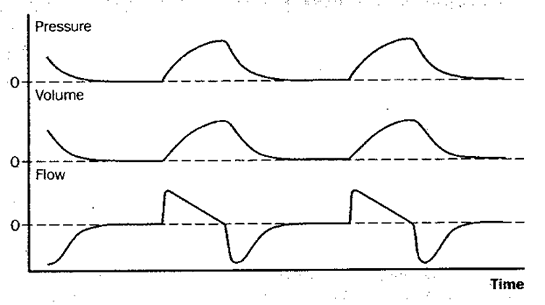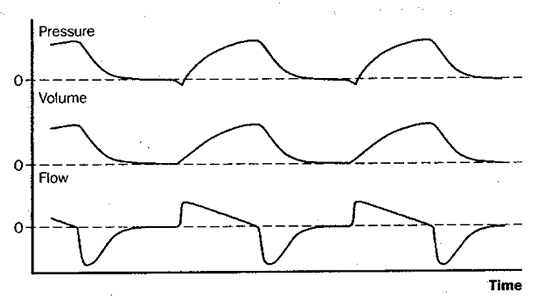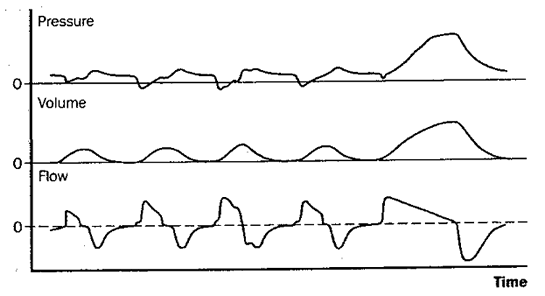Volume-Targeted Modes
The most commonly used volume-targeted ventilator modes are assist/control (A/C, or AMV) and synchronized intermittent mandatory ventilation (SIMV). Figures 2-4 illustrate these schematically along with controlled mechanical ventilation (CMV), conceptually the “default mode” of volume-targeted ventilation. With CMV, the patient receives a preset number of fixed-volume breaths and cannot increase minute ventilation by triggering more machine breaths or by breathing spontaneously between them. The difference between A/C ventilation and CMV is that the patient may trigger additional fixed-volume machine breaths if desired. With intermittent mandatory ventilation (IMV), a fixed number of preset-volume breaths is delivered by the ventilator and, if desired (and capable), the patient can also breathe spontaneously from the ventilator circuit. Conceptually, IMV is therefore somewhat like being on both CMV and a T-piece at the same time. The theoretic risk of ‘stacking’ a mandatory breath on top of a large spontaneous breath, which might produce barotrauma, means that most ventilators deliver IMV in such a way that mandatory breaths can only be delivered after expiration is sensed, called SIMV.
Fig 2: controlled mechanical ventilation (CMV)

Figure 2: Schematic depiction of changes in pressure at the airway opening, lung volume, and flow during controlled mechanical ventilation (CMV). With CMV, all breaths are machine-triggered mandatory breaths, and the patient is passive throughout the cycle.
Fig 3: assist/control ventilation (A/C, or AMV)

Figure 3: Schematic depiction of changes in pressure at the airway opening, lung volume, and flow during assist/control mechanical ventilation (A/C, or AMV). Assist/control is essentially the same as CMV except that the patient may, if desired, trigger the set-volume machine breaths at a more rapid rate. Note on the pressure tracing that in this example each breath is patient-triggered, as shown by the slight negative deflection of the airway pressure tracing as it is initiated.
Fig 4: synchronized intermittent mandatory ventilation (SIMV)

Figure 4: Schematic depiction of changes in pressure at the airway opening, lung volume, and flow during synchronized intermittent mandatory ventilation (SIMV). With SIMV, a set number of machine-triggered, mandatory breaths are delivered, as with CMV. However, in SIMV the patient can also breathe spontaneously between mandatory breaths if desired. When the mandatory rate in SIMV is sufficient to provide all the ventilation the patient needs, this mode is effectively the same as CMV.
Full ventilatory support is provided by CMV, which means that all work performed on the respiratory system during ventilation is provided by the ventilator (the patient is passive). In A/C ventilation, full ventilatory support is provided when the patient is not triggering, but partial ventilatory support when the patient breathes at a rate greater than the fixed backup rate. Studies have shown that patient work can be substantial in A/C, continuing throughout the inspiratory phase, particularly if the patient is air-hungry and the inspiratory flows provided by the ventilator are low. In SIMV, full ventilatory support is provided when the patient is not attempting to breathe above the mandatory rate, and partial ventilatory support when any spontaneous ventilation is present.
 Top of Page
Top of Page
< Previous:
Contraindications To Invasive Mechanical Ventilation | Next:
Pressure-Targeted Modes